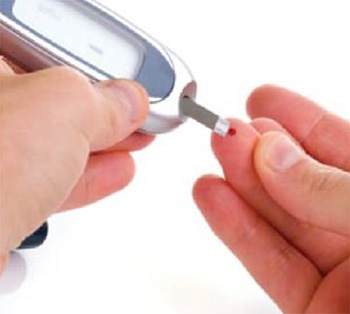Pediatric Diabetes
Blood glucose testing and goals

Hemoglobin A1c Test (also called “A1c”)
Hemoglobin A1c is a blood test that measures the average blood glucose over the past 3 months. It is measured as a percentage. A higher A1c means blood glucose has been consistently higher over those three months.
A1c is a useful tool for monitoring risk for complications related to diabetes. Long-term high blood glucose is related to negative effects on brain function, brain structure, and brain development in children and teens with diabetes.
Your A1c will be checked with each clinic visit with a fingerstick, with your labs, or with an at-home testing kit.
For children, the A1c goal is 7% unless unable to verbalize symptoms of hypoglycemia.
When do you test blood glucose?
You will test your blood glucose at home using a blood glucose meter (glucometer). You should check your blood glucose:
- before meals, before bedtime, and at 2 a.m. (5 times per day), and
- when there are symptoms of high or low blood glucose.
What are your blood glucose goals?
Here are starting blood glucose goals:
| Daytime | 71-180 mg/dL |
| Bedtime | 101-200 mg/dL |
The goal is to keep blood glucose in the target range most of the time. Target blood glucose will change as you learn more about diabetes. Some things to keep in mind:
- Targets may be different based on age, size, activity level, pancreas function, etc.
- There will always be a rise in blood glucose after meals. The goal is for the blood glucose to come back down to target range before the next meal.
- You will learn to treat blood glucose 70 mg/dL or less with fast-acting carbohydrate (see page on “Hypoglycemia”). Blood glucoses in the 71-80 mg/dL range are safe, but if blood glucoses are dropping, we want you to treat them with carbohydrate before they reach lower levels.
- If blood glucoses are frequently outside your goal range then insulin dose adjustments may be needed.
Things you will need to test your blood glucose:
- Lancet
- Finger stick device
- Test strip
- Blood glucose meter
- Cotton ball for blotting
- Blood glucose diary
How to check blood glucose:
- Wash and dry your hands.
- Food or drink left on a finger before testing can cause a falsely high glucose reading.
- A slightly wet finger can cause a falsely low glucose reading. You should completely clean and dry a finger before testing.
- Turn meter on.
- Check that the date and time on meter are correct. Read instruction manual. Set-up may change from one meter to the next.
- Place strip in meter.
- Perform finger stick.
- Bring finger to test strip. Fill test strip with blood. Wait for result.
- Wipe finger with a cotton ball or tissue.
- Record blood glucose results in blood glucose diary.

